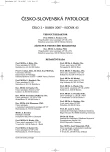Non-Hodgkin’s Lymphomas (from Rappaport to WHO 2001 and Nowadays). Review
Authors:
J. Mačák 1; L. Plank 2
Authors‘ workplace:
Ústav patologie Lékařské fakulty Masarykovy univerzity a Fakultní nemocnice, Brno
1; Ústav patologickej anatómie Jesseniovej lekárskej fakulty v Martine Univerzity
Komenského, Bratislava
2
Published in:
Čes.-slov. Patol., 43, 2007, No. 2, p. 39-49
Category:
Reviews Article
Overview
In the last decades, considerable changes in the classification of lymphomas have been made. In addition to morphology and immunohistochemistry, the last WHO (2001) classification also utilizes cytogenetics and molecular biology. In many cases classification notices oncogenic mechanisms. The authors describe some differences in immunophenotype in certain entities: chronic lymphocytic leukaemia/ small lymphocytic lymphoma - CLL/SLL, follicular lymphoma - FL, mantle cell lymphoma -MCL, diffuse large B-cell lymphoma – DLBCL, and anaplastic large cell lymphoma - ALCL, mainly with respect to prognosis. The authors point out to heterogeneity within the individual types of lymphomas from the point of view of morphology, immunohistochemistry and molecular biology.
Recently it has been shown, that differences in prognosis are not limited to individual nosologic entities, but also may be found within the particular category of lymphoma. For example, CLL/SLL is divided in two different subunits according to mutational status of variable segment (VH) of the immunoglobulin heavy chain gene. The cases with unmutated VH segment display progressive disease which is in contrast to cases with the same morphology but with mutated VH segment. Similar differences were found in MCL. Attention is drawn to oncogenic and apoptosis-regulating mechanisms, such as gene p53 and the Bcl-2 family.
Key words:
non-Hodgkin’s lymphoma – immunohistochemistry – molecular pathology – classification
Labels
Anatomical pathology Forensic medical examiner ToxicologyArticle was published in
Czecho-Slovak Pathology

2007 Issue 2
Most read in this issue
- Cutaneous Angiosarcoma Following Conservative Surgery and Radiotherapy for Breast Carcinoma. A Case Report
- Extrapleural Solitary Fibrous Tumor Mimicking Lateral Neck Cyst – a Case Report
- Non-Hodgkin’s Lymphomas (from Rappaport to WHO 2001 and Nowadays). Review
- Problems of Suitability Laser’s Excision of Pigmented Dermal Lesions: Case Report of Minimal Deviation Melanoma
